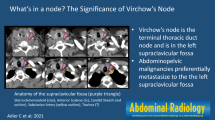Abstract
Between April 1988 and July 1995, 11 children with a lymphangioma were treated with intralesional OK-432 injection. In 7 patients it was the primary therapy and total shrinkage of the lesion was obtained in 5 of them. Two patients did not respond and the children underwent surgery. Following incomplete surgical removal or recurrence of the lymphangioma, intralesional OK-432 injection was used as secondary therapy in 4 patients. Total regression was observed in 2 cases and marked regression in the 2 others. No serious side-effects except fever lasting for 2–3 days and slight tenderness with swelling of the lymphangioma for 3–4 days after the injection was noted. Local inflammatory reaction did not cause any damage to the overlying skin and did not lead to scar formation. Depending on the size, location, and anatomical relationship to the airway, intralesional injections of the lymphangiomas were performed under general anaesthesia and the children were observed for 24 h. There was no recurrence after follow up periods ranging from 2 months to 7 years.
Similar content being viewed by others
References
Filston HC (1994) Hemangiomas, cystic hygromas, and teratomas of the head and neck. Semin Pediatr Surg 3 (3):147–159
Hancock BJ, Dickens St-Vil, Francois I Luks. Maria Di Lorenzo, Blanchard H (1992). Complications of lymphangiomas in children. J Pediatr Surg 27 (2):220–226
Ishida N, Hoshino T (1985) A streptococcal preparation as a potent biological response modifier OK-432. Excerpta Medica, 2nd edn. Amsterdam, pp 1–5, 26–47, 60–62
Ogita S, Tsuto T, Tokiwa K, Takahashi T (1987) Treatment of cystic hygroma in children with special reference to OK-432 therapy. Z Kinderchir 42: 279–281
Ogita S, Tsuto T, Tokiwa K, Takahashi T (1987) Intracystic injection of OK-432: a new sclerosing therapy for cystic hygroma in children. Br J Surg 74: 690–691
Ogita S, Tsuto T, Deguchi E, Tokiwa K, Nagashima M, Iwai N (1991) OK-432 therapy for unresectable lymphagiomas in children. J Pediatr Surg 26 (3):263–270
Ogita S, Tsuto T, Nakamura K, Deguchi E, Iwai N (1994) OK-432 therapy in 64 patients with lymphangioma. J Pediatr Surg 29 (6):784–785
Oshimi K, Wakasugi H, Seki H (1980) Streptococcal preparation OK-432 augments cytotoxic activity against an erythroleukemic cell line in humans. Cancer Immunol Immunother 9:187–192
Ravitch MM, Rush BJ Jr (1986) Cystic hygroma. In: Welch KJ, Randolph JG, Ravitch MM, et al (eds) Pediatric surgery, vol 1, 4th edn. Year Book Medical Publishers, Chicago, pp 533–539
Stringel G (1993) Hemangiomas and lymphangiomas. In: Ashcraft KW, Holder ThM (eds) Pediatric surgery, 2nd edn. WB Saunders Company, Philadelphia, pp 812–822
Talmadge JE, Herberman RB (1986) The preclinical screening laboratory: evaluation of immunomodulatory and therapeutic properties of biological response modifiers. Cancer Treat Rep 70:171–182
Tanaka K, Inomata Y, Utsunomiya H, Uemoto S, Asonma K, Katayama T, Ozawa K, Hashida M (1990) Sclerosing therapy with bleomycin emulsion for lymphangioma in children. Pediatr Surg Int 5:270–273
Author information
Authors and Affiliations
Rights and permissions
About this article
Cite this article
Schmidt, B., Schimpl, G. & Höllwarth, M.E. OK-432 therapy of lymphangiomas in children. Eur J Pediatr 155, 649–652 (1996). https://doi.org/10.1007/BF01957145
Received:
Accepted:
Issue Date:
DOI: https://doi.org/10.1007/BF01957145




